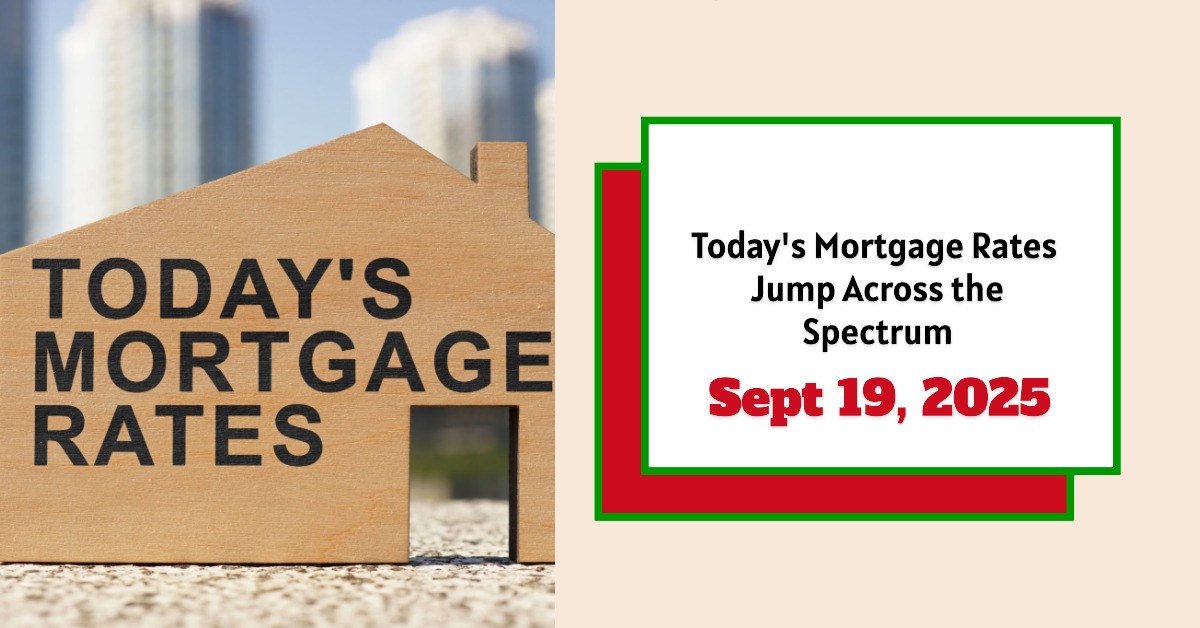Mortgage rates today, September 19, 2025, have increased across the board despite the Federal Reserve's recent interest rate cut of 25 basis points. The average 30-year fixed mortgage rate rose to 6.56%, a climb of 11 basis points from the previous week's 6.45%. Refinance rates followed a similar trend with the 30-year fixed refinance rate climbing to 7.08%, up 43 basis points. This rise is somewhat unexpected given that rate cuts generally aim to reduce borrowing costs, but ongoing economic factors are pushing mortgage rates higher for now.
Today's Mortgage Rates – September 19, 2025: Rates Rise Across The Spectrum
Key Takeaways
- 30-year fixed mortgage rate increased to 6.56% from 6.45% last week
- 15-year fixed mortgage rate rose from 5.71% to 5.79%
- 30-year fixed refinance rate surged to 7.08%, up 43 basis points week-over-week
- Federal Reserve cut benchmark interest rate by 0.25%, but mortgage rates rose nonetheless
- Rate volatility and economic concerns continue to affect market-driven mortgage rates
- Forecasts predict a potential gradual decline in rates toward 6% by early 2026
Current Mortgage Rates by Loan Type
Based on data from Zillow as of September 19, 2025, here are the national average mortgage rates for various loan programs:
| Loan Type | Rate (%) | 1 Week Change | APR (%) | APR 1 Week Change |
|---|---|---|---|---|
| 30-Year Fixed | 6.56 | +0.11 | 6.99 | +0.09 |
| 20-Year Fixed | 6.00 | -0.21 | 6.48 | -0.09 |
| 15-Year Fixed | 5.79 | +0.28 | 6.09 | +0.28 |
| 10-Year Fixed | 5.84 | +0.06 | 6.23 | +0.14 |
| 7-Year ARM | 6.94 | +0.56 | 7.87 | +0.44 |
| 5-Year ARM | 7.19 | +0.19 | 7.87 | +0.18 |
Government-Supported Loans
| Loan Type | Rate (%) | 1 Week Change | APR (%) | APR 1 Week Change |
|---|---|---|---|---|
| 30-Year FHA Fixed | 5.68 | +0.02 | 6.69 | +0.02 |
| 30-Year VA Fixed | 5.92 | +0.02 | 6.14 | +0.04 |
| 15-Year FHA Fixed | 5.37 | +0.14 | 6.33 | +0.14 |
| 15-Year VA Fixed | 5.46 | -0.11 | 5.81 | -0.09 |
Current Refinance Rates
Refinancing rates have surged in line with purchase mortgage rates. This indicates that borrowers looking to refinance may face higher costs now despite the Federal Reserve's rate cut. The national average refinance rates are:
| Loan Type | Rate (%) | 1 Week Change |
|---|---|---|
| 30-Year Fixed Refi | 7.08 | +0.20 |
| 15-Year Fixed Refi | 5.77 | +0.11 |
| 5-Year ARM Refi | 7.39 | +0.05 |
The Fed’s Interest Rate Cut and Its Impact on Mortgage Rates
On September 17, 2025, the Federal Reserve lowered its benchmark interest rate by 0.25% to the range of 4.0% to 4.25%. This was the first rate cut in 2025 after a series of pauses and three cuts in late 2024. The Fed described this move as a cautious “risk-management cut” due to signs of economic slowing and a softening job market, with unemployment rising slightly to 4.3%. Despite inflation remaining above the 2% target, the Fed’s priority is balancing economic growth with inflation concerns.
However, mortgage rates have not dropped as expected after the Fed's rate cut. Here's why:
- Mortgage rates are driven by the 10-year U.S. Treasury yield, which reacts to broader economic risks and inflation expectations, not just short-term Fed policy.
- Market volatility and geopolitical concerns keep treasury yields—and mortgage rates—a bit elevated.
- Investors demand higher returns for long-term risks, pushing mortgage rates up.
- Adjustable Rate Mortgages (ARMs) are somewhat more responsive to Fed policy since their rates reset with short-term indexes tied to the Fed's decisions.
Example Calculation
To illustrate how the change in mortgage rates affects monthly payments, consider a 30-year fixed mortgage for $300,000:
| Rate (%) | Monthly Payment (Principal & Interest) |
|---|---|
| 6.45% (a week ago) | $1,898 |
| 6.56% (today) | $1,912 |
An 11 basis-point increase raised monthly payments by about $14. Over 30 years, this amounts to nearly $5,040 more in interest alone.
Market Forecast and Trends
Looking ahead, major housing forecasters provide these perspectives on mortgage rates:
- National Association of REALTORS® anticipates rates will average 6.4% in the second half of 2025, dipping further to 6.1% in 2026. Lower mortgage rates are expected to improve buyer affordability and increase demand.
- Realtor.com projects mortgage rates easing slowly, aligning with prior year averages around 6.4% by year-end 2025.
- Fannie Mae expects 2025 and 2026 year-end rates at 6.5% and 6.1%, respectively, with mortgage originations rising.
- The Mortgage Bankers Association forecasts a 30-year mortgage rate rising to 6.7% by year-end 2025 and declining to 6.5% by the end of 2026. They emphasize rate volatility will continue to impact refinance opportunities.
Why Are Mortgage Rates Rising Despite a Fed Rate Cut?
It might seem counterintuitive but mortgage rates often do not move immediately with Fed rate changes. Here’s why:
- Mortgage lending is tied more closely to long-term bond yields than short-term rates set by the Fed. If investors worry about inflation or other risks, the yield on the 10-year Treasury—which heavily influences mortgage rates—can rise regardless of the Fed’s actions.
- The Fed’s “dot plot” shows only two more expected rate cuts in 2025, indicating cautious optimism but not aggressive easing. Markets may price in risks that keep yields higher.
- Economic data such as inflation and labor market shifts can quickly change investor behavior, altering bond yields and mortgage rates almost daily.
- The Fed rate cut does improve conditions for adjustable-rate loans and helps variable-rate consumer credit products, but fixed mortgage rates adjust more slowly and often reflect expectations for inflation and growth over years, not just months.
The Federal Reserve and Its Role in Mortgage Rate Movement
Though the Federal Reserve does not directly set mortgage rates, its policies influence them indirectly through economic signals:
- By lowering the federal funds rate, the Fed aims to reduce borrowing costs, stimulating economic activity. This generally puts downward pressure on mortgage rates.
- However, inflation concerns can counteract this downward pressure—if inflation is expected to remain high, mortgage rates tend to rise as lenders demand higher returns.
- The Fed’s messaging and rate decisions shape investor confidence—which affects Treasury yields and in turn mortgage rates.
- The recent rate cut signals the Fed's recognition of economic slowdowns but maintains a cautious stance on inflation containment.
Related Topics:
Mortgage Rates Trends as of September 18, 2025
Mortgage Rates Predictions Next 90 Days: August to October 2025
Understanding Adjustable-Rate Mortgages (ARMs) in Today’s Market
ARMs are a popular option in a rising-rate environment because their initial rates can be lower than fixed-rate mortgages. With the Fed’s recent rate cut:
- Short-term rates tied to benchmarks like the LIBOR or SOFR may adjust downward.
- Borrowers with ARMs may benefit sooner from lower monthly payments when their rate adjusts.
- However, ARMs carry risks if rates rise again, so borrowers must weigh the potential savings with the risk of future hikes.
Current 5-year ARM rates are about 7.19% for purchases and 7.39% for refinancing, reflecting slightly higher costs but potentially more flexibility.
How Rate Changes Affect Homebuyers and Sellers
- For homebuyers, rising mortgage rates mean higher monthly payments, potentially reducing purchasing power. This can slow demand or push buyers toward smaller or less expensive homes.
- For homeowners considering refinancing, the recent surge in refinance rates could diminish savings opportunities for those with existing lower-rate loans.
- For sellers, lower mortgage rates that may materialize in coming months could stimulate more buyer activity. However, inventory shortages remain a challenge in many markets.
- The interplay of rising mortgage rates amid economic uncertainty suggests that buyers and sellers alike must stay alert to rate shifts.
Capitalize Amid Rising Mortgage Rates
With mortgage rates expected to remain high in 2025, it’s more important than ever to focus on strategic real estate investments that offer stability and passive income.
Norada delivers turnkey rental properties in resilient markets—helping you build steady cash flow and protect your wealth from borrowing cost volatility.
HOT NEW LISTINGS JUST ADDED!
Speak with a seasoned Norada investment counselor today (No Obligation):
(800) 611‑3060
Also Read:
- Will Mortgage Rates Go Down in 2025: Morgan Stanley's Forecast
- Mortgage Rate Predictions 2025 from 4 Leading Housing Experts
- Mortgage Rate Predictions for the Next 3 Years: 2026, 2027, 2028
- 30-Year Fixed Mortgage Rate Forecast for the Next 5 Years
- 15-Year Fixed Mortgage Rate Predictions for Next 5 Years: 2025-2029
- Will Mortgage Rates Ever Be 3% Again in the Future?
- Mortgage Rates Predictions for Next 2 Years
- Mortgage Rate Predictions for Next 5 Years
- Mortgage Rate Predictions: Why 2% and 3% Rates are Out of Reach
- How Lower Mortgage Rates Can Save You Thousands?
- How to Get a Low Mortgage Interest Rate?
- Will Mortgage Rates Ever Be 4% Again?



